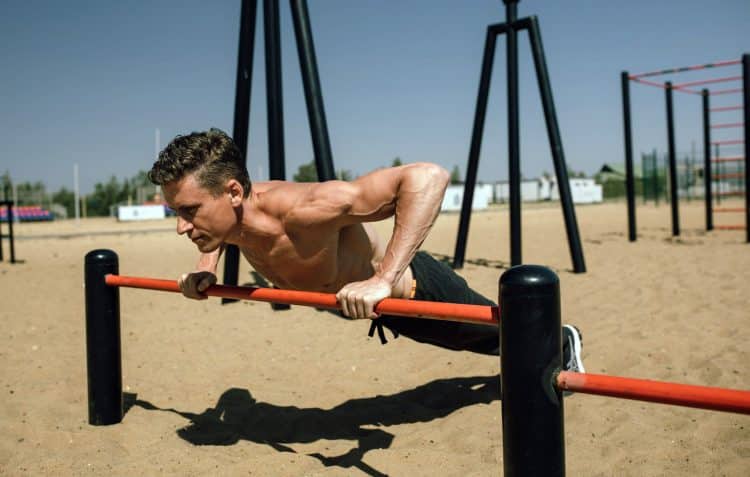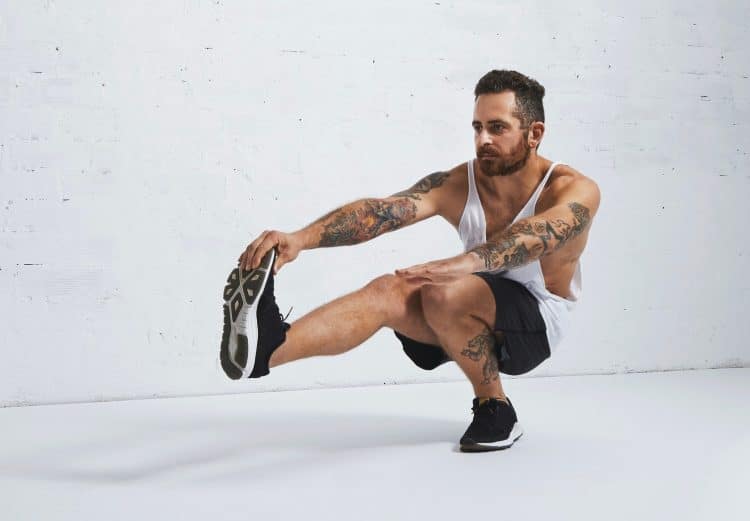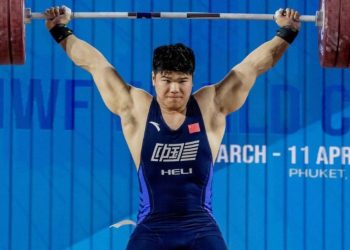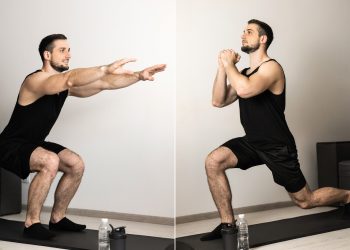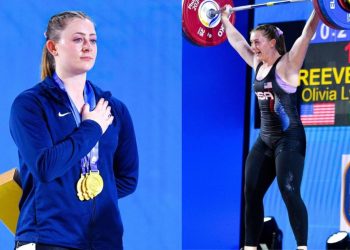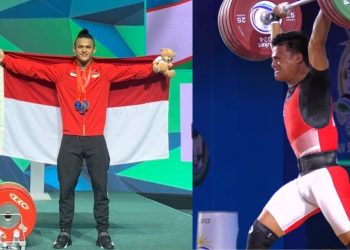Should you make calisthenics the cornerstone of your workouts? Or is weightlifting the best way to build muscle and strength? I’m here to help you decide!
I’ve been strength training for almost as long as I can remember. I bought my first weights and workout bench when I was in my early teens, and I’ve been lifting ever since. That said, over almost four decades, my reasons for lifting have changed several times.
Like most young men, I started out wanting to gain weight and get more muscular. I was a skinny kid! But then, as my interest in sports started to develop, I lifted weights to improve my athletic performance.
Strength Training Benefits
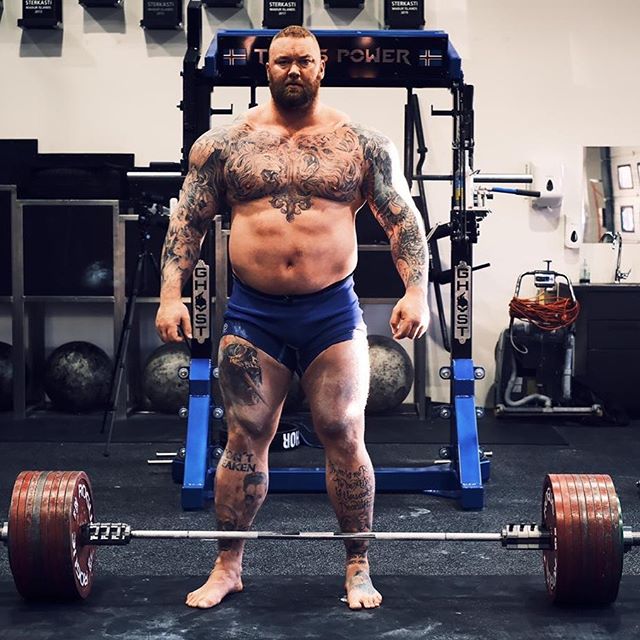
Eventually, weightlifting became my sole sporting focus, and I graduated to competitive powerlifting. I even won a few meets! But, nowadays, I lift mainly to preserve muscle mass and for the many documented health benefits strength training provides (1).
These include:
- Increased bone mass
- Lower risk of type II diabetes
- Improved cardiovascular health
- Lower resting blood pressure
- Reduced risk of lower back pain
- Less joint pain
- Greater functional strength
- Slower aging
- And many, many more!
During my lifting “career,” I’ve experimented with numerous training styles, from high-volume workouts to single-set HIT. I’ve dabbled in Olympic lifting and tried every conceivable training system to make my workouts as effective as possible. After all, time and energy are valuable commodities, so why waste them doing things that don’t work?
Consequently, I’ve often wondered if other forms of training are as effective as weightlifting for muscle strength and size. It turns out I’m not the only person to pose this question!
So, in this article, I’m going to explore the effects and benefits of calisthenics vs. weightlifting to finally determine which is better.
To clarify, by “weightlifting,” I don’t mean the clean, jerk, and snatch, i.e., the Olympic lifts. Instead, I mean lifting weights to make your muscles grow and get stronger. So, when you see weightlifting, strength training, or resistance training in this article, assume I’m talking about the same thing.
Understanding Calisthenics and Weightlifting
Before I get into which one is better, in this section, I want to discuss what calisthenics and weightlifting actually are. That way, there will be no confusion regarding which of these training methods is which.
An Introduction to Calisthenics
Calisthenics is also known as bodyweight training, which tells you pretty much all you need to know about this workout. The word calisthenics comes from the Greek for beauty and strength. And while I can’t guarantee calisthenics will make you beautiful, it has the potential to make you stronger.
Calisthenics has been around for thousands of years and is currently enjoying a resurgence in interest. It’s popular with martial artists, boxers, and the military and ideal for anyone who wants to train at home instead of in a commercial gym.
There are hundreds, if not thousands, of calisthenic exercises, which can be divided broadly into Progressive and Skill-Based calisthenics. Progressive calisthenics includes exercises like push-ups, lunges, pull-ups, etc.
In contrast, skill-based calisthenic exercises are more akin to gymnastics. These include muscle-ups, front and back levers, skin-the-cat, and other technically demanding exercises.
Most calisthenic exercises are compound in nature, meaning they involve multiple joints and several muscle groups simultaneously. There are comparatively few calisthenic isolation exercises.
You can perform many calisthenic exercises without equipment. In fact, for many, all you need is some floor space. However, other movements require additional equipment, such as pull-up and dip bars, parallettes, suspension trainers, or gymnastic rings. Accordingly, it’s up to you whether you use these tools, and some people prefer to rely solely on their body weight.
Related: The 11 Best FREE Calisthenic Programs
An Introduction to Weightlifting
It should be no surprise to learn that weightlifting involves lifting weights! Those weights can take the form of barbells, dumbbells, kettlebells, resistance training machines, or any other external load.
Like calisthenics, weightlifting has been around for a long time, although bodyweight training is probably the original strength training workout.
There are thousands of weightlifting exercises, and you can do many of them with more than one type of training equipment. For example, you can do overhead presses with a barbell, one or two dumbbells, a shoulder press machine, a cable machine, kettlebells, sandbags, a medicine ball, and seated or standing.
Other popular weightlifting exercises include:
- Bench press
- Squats
- Deadlifts
- Leg press
- Lat pulldowns
- Biceps curls
- Preacher curls
- Lateral raises
Weightlifting exercises can be compound or isolation, and there are exercises you can use to target most of your muscles with laser-like precision. The weights themselves are generally adjustable, so you can fine-tune your workout according to your strength, needs, and goals.
For example, you can use lighter loads when learning a new exercise or just starting out, increasing the weights as you get stronger to ensure your muscles continue to develop and grow.
While you can do weightlifting at home, most exercisers work out in a gym. That way, they have access to a far wider range of training equipment. Consequently, some people have gyms at home, and the “garage gym” community is growing fast. After all, you only need a barbell, a bench, and a squat rack to get a good workout at home. Add a set of adjustable dumbbells, and you can train virtually every muscle in your body.
Now that you know a little more about these two different types of training, in the next section, we’ll delve into their specific benefits.
The Benefits of Calisthenics
Many exercisers describe bodyweight training as the perfect workout. After all, calisthenics literally means beautiful strength, which sounds very appealing! While no workout is without drawbacks, calisthenic does offer a range of notable benefits. These include:
Convenience and Low Cost
Lack of time and facilities are two of the biggest barriers to consistent exercise. We all lead busy lives, and when time is short, our workouts are often the first casualty. After all, simply driving to and from the gym can take valuable time out of your day. In addition, gym memberships can be expensive.
All of these barriers are non-issues with calisthenics. You can work out almost anywhere, negating the need to travel, and you can practice bodyweight training without equipment. This all makes calisthenics the perfect excuse-free workout. In fact, you could do a set of push-ups or air squats right now. How’s that for convenience?
Improved Athleticism and Functional Strength
Many calisthenic exercises can be described as “functional,” meaning they transfer well to activities outside the gym. This is because they teach you how to control your body. Calisthenic training is especially useful for improving mobility, flexibility, balance, coordination, and stability.
Functional exercises are excellent for athletes and anyone who wants to use their strength in everyday life. In contrast, some weight training exercises have much less carryover to the real world, such as leg extensions and calf raises, which are movements seldom done outside of a gym.
Whole-Body Training and Core Strength
With calisthenics training, your body acts as the weight, bench, and resistance machine. As such, many upper body movements engage your legs and core. Therefore, it’s not unreasonable to say that a lot of calisthenic movements are full-body exercises, even when you use them to target specific body parts or muscle groups.
This means you can train your entire body, directly and indirectly, with just a few exercises. This means your workouts can be more time-efficient. For example, a few sets of pull-ups, dips, and walking lunges work pretty much every major muscle group, including your core.
Progression and Challenge
Most calisthenic exercises can be adapted to make them more challenging. For example, you might use the following push-up progressions:
- Incline push-ups (hands on a wall)
- Incline push-ups (hands on a bench)
- Kneeling push-ups
- Regular push-ups
- Wide grip push-ups
- Diamond push-ups
- Deficit push-ups
- Decline push-ups (feet on a bench)
- Weighted push-ups
- Gymnastic ring push-ups
- Plyometric push-ups
- Archer push-ups
- Pseudo planche push-ups
- One-arm push-ups
- Handstand push-ups
- Planche push-ups
With these exercises, the basic movement remains the same, but by changing things like the angle of your body or the position of your hands, you can go from an easy workout to one that’ll challenge an Olympic gymnast. Contrary to popular belief, this means that calisthenics aren’t just for beginners.
In contrast, you’ll never outgrow the challenge of calisthenics training. Working through these and similar progressions can help keep you motivated and also provide a way to increase the overload on your muscles. You don’t have to limit yourself to doing more reps.
Safety
With no weights to drop, calisthenics is a very safe workout. With many bodyweight exercises, you can train to failure with no risk of accident or injury. That’s not to say you can’t hurt yourself with calisthenics training. Poor form or failing to warm up can lead to sprains and strains. However, serious injuries are unlikely compared to heavy weightlifting.
It’s also worth noting that many calisthenic exercises involve natural movements. Ultimately, they are often more joint-friendly than their weightlifting counterparts.
Versatile
You can train for almost any goal with calisthenics. Bodyweight training builds strength, muscle mass, muscular endurance, and power. You can also combine exercises into circuits and HIIT workouts to build cardiovascular fitness and burn fat. In short, calisthenics is highly versatile.
Needless to say, using calisthenics for different goals means you’ll need to adapt your training accordingly. For example, if you want to build endurance and burn fat, high-rep bodyweight exercises performed as a circuit are perfect. But, if you want to build strength, low-rep single-limb movements are probably best.
Aesthetic Appeal
Calisthenic exercises don’t just build fitness, strength, and muscle; they have tremendous aesthetic appeal, too. By that, I mean they look cool and imposing. For example, I know I turn heads when I show up at the gym and do high-rep sets of pull-ups and dips. These are feats of strength that many people are unable to accomplish.
Other calisthenic exercises that are incredibly impressive (that I cannot do!) include planche push-ups, single-arm pull-ups, pistol squats, and hand balancing.
In summary, the benefits of calisthenics include:
- Convenience and low cost
- Improved athleticism and functional strength
- Whole-body training and core strength
- Progression and challenge
- Safety
- Versatile
- Aesthetic appeal
The Benefits of Weightlifting
For this article, weightlifting refers to any type of strength training that uses an external load. This includes barbells, dumbbells, kettlebells, resistance machines, sandbags, medicine balls, etc. Using weights to challenge your muscles provides several notable benefits:
Progressive Overload
Making a weightlifting exercise harder is as simple as putting more weight on the bar or moving the selector pin down a hole. This straightforward process makes it easy to progress your workouts as you get stronger. You don’t even need to change your repetition range or chosen exercises. Just add a few pounds and your muscles will improve.
These measured increases make it easy to keep track of your workouts and measure your progress. It can be very motivating to see your training weights go up. That said, you don’t have to increase your weights if you don’t wish, and there are plenty of other ways to make your exercises more demanding. These include:
- Increase the reps
- Do more sets
- Use more challenging exercises
- Take shorter rests between sets
- Train more often
Read more on Progressive Overload.
No Upper Weight Limits
Weightlifting is arguably the best way to develop brute strength. That’s because the best exercises have no real upper weight limit. For example, at the time of writing, the current world record for the deadlift is 501 kilograms/1102 pounds. Strongman Hafþór (Thor) Júlíus Björnsson from Iceland is the holder.
It goes without saying that Thor trained long and hard to achieve this standard, and his workouts revolved around weightlifting exercises. Even the most challenging calisthenic exercises don’t come close to the strength needed to lift over 500kg!
Target Specific Muscles More Easily
External weights make it easy to target muscles and muscle groups. Some exercises go so far as to isolate specific muscles. For example, you can use leg extensions to hit the quadriceps or leg curls for the hamstrings. Benches and machines mean that you don’t have to stabilize or support the parts of your body you are not using directly. This can be beneficial for hypertrophy training or bodybuilding.
Imbalance Correction
Leading on from the point above, weightlifting exercises make it easy to address muscle imbalances and weaknesses. For example, if your mid-trapezius and rhomboids are weak, leading to poor posture, you can work them directly with exercises such as face pulls and reverse flys. This is often less practical with calisthenics.
Variety
There are hundreds, if not thousands of weightlifting exercises to choose from. You can perform many of these exercises in multiple ways using a range of equipment.
You can also adjust your stance or grip width, do unilateral or bilateral exercises, or work out seated, standing, or even kneeling. As such, strength training need never be boring, as there are always new exercises to try. Regardless of your current strength or experience level, there are weightlifting exercises to suit your needs and goals.
Train for Any Goal
You can adapt weightlifting for any goal, from building muscle to burning fat. It all comes down to how you program each exercise and organize your workouts. Such versatility means that weightlifting is useful for everyone, regardless of why they’re exercising.
Starting with light loads also means that weightlifting is ideal for beginners and very deconditioned people. It can be adapted for all ages and even cater to special population groups, such as those suffering from chronic diseases.
In summary, the benefits of weightlifting include:
- Progressive overload
- No upper weight limits
- Target specific muscles more easily
- Imbalance correction
- Variety
- Train for any goal
Comparing Calisthenics and Weightlifting
Now you know a little more about calisthenics and weightlifting, let’s see how they stack up against one another in terms of effectiveness for different training goals.
Calisthenics vs. Weightlifting – Muscular Endurance
Muscular endurance, not to be confused with cardiovascular endurance, is the ability of your muscles to produce low amounts of force for extended periods. Muscular endurance is your ability to resist fatigue, which is beneficial in sports and everyday life. You typically develop muscular endurance by doing high-rep sets with low weights and short rests.
Considering these training parameters, you can improve your muscular endurance with calisthenics or weightlifting exercises. Both should be equally effective.
Calisthenics vs. Weightlifting – Hypertrophy
Hypertrophy is the process through which muscles get bigger. It’s the result of several factors, including muscle tension, metabolic stress, muscle overload, and microtrauma. Simply put, after a taxing workout, and with adequate rest, recovery, and nutrition, your muscles grow back slightly bigger than before.
In theory, any form of exercise stress can cause muscle growth. In fact, a study published on PubMed suggests that push-ups and bench presses are equally good for muscle growth (2). However, while calisthenics can cause hypertrophy, it’s probably not the best option if that is your primary goal.
Weightlifting allows you to target specific muscles and muscle groups with laser-like precision, which enhances muscle growth. Also, the ability to easily change the load means you can fine-tune your workouts to overload your muscles more efficiently. In summary, while calisthenics does build muscle, weightlifting arguably does it better.
Calisthenics vs. Weightlifting – Strength
Strength is your ability to generate force. The stronger you are, the more weight you’ll be able to lift. Progressing from basic to more challenging calisthenics exercises will make you stronger, but with increased difficulty comes an increase in skill requirement. In many cases, lack of skill will stop you from progressing to the next level.
On the flip side, building strength with weightlifting is as simple as slapping more weight on the bar. This process also makes it easier to quantify your progress.
So, while calisthenics will make you stronger, weightlifting is probably the best tool if you want to maximize strength.
Calisthenics vs. Weightlifting – Power
Power is force generated quickly. For example, it’s the difference between a heavy barbell squat and an explosive squat jump. Power is a critical part of many sports, and a valuable asset during strenuous everyday activities, such as heavy lifting, running upstairs, or simply getting out of a low chair.
There are calisthenic power exercises, such as squat jumps, plyometric push-ups, and explosive pull-ups. In contrast, weightlifting power exercises include power cleans, snatches, and push-presses.
In conclusion, while both types of training can make you more powerful, calisthenics is potentially a better option because the exercises are easier to learn and more accessible. You can do most bodyweight power exercises virtually anywhere and anytime. In contrast, weightlifting power exercises are highly technical and often require special equipment.
Calisthenics vs. Weightlifting – Fat Burning
Cardio is not the only way to burn fat and get lean. In fact, metabolic workouts, HIIT, and circuit training are all effective fat burners. As an advantage, these methods preserve muscle mass and trigger something called EPOC, short for excess post-exercise oxygen consumption, and also known as the “afterburn effect.”
EPOC describes how your metabolism increases for as long as 48 hours after an intense workout, further increasing your caloric expenditure (3).
Non-cardio fat-burning workouts invariably involve doing several compound exercises back to back. For example:
| # | Exercise | Work/Rest | Rounds |
| 1 | Squats | 40 seconds/20 seconds | Do 3-5 rounds, resting 1-2 minutes between each |
| 2 | Push-ups | 40 seconds/20 seconds | |
| 3 | Lat pulldowns | 40 seconds/20 seconds | |
| 4 | Leg press | 40 seconds/20 seconds | |
| 5 | Planks | 40 seconds/20 seconds |
Providing you can transition quickly from one exercise to the next, you can use calisthenics, weightlifting, or a combination of these approaches to burn calories and fat.
Calisthenics vs. Weightlifting – Cardiovascular Fitness
Fat burning and cardiovascular training often go hand in hand. In fact, all the training methods outlined in the section above also involve the cardiovascular system, which comprises your heart, lungs, and circulatory system.
When you do any type of strength training exercise, your heart and breathing rise to pump oxygenated blood to the area you are working. Switching exercises makes this happen again and again, resulting in a sustained increase in cardiovascular work despite not doing conventional cardio exercises.
Subsequently, using any form of strength training to burn fat will also improve your cardiovascular fitness. Studies published on PubMed support the use of strength training to improve cardiovascular fitness and health (4).
Calisthenics vs. Weightlifting – Functional Strength
Functional strength is your ability to exert force during everyday and athletic activities. It enhances your performance of natural movements, such as lifting, carrying, pushing, pulling, and locomotion, i.e., walking and running. Being functionally strong makes many of life’s challenges easier to overcome. It also helps injury-proof your body.
While lifting weights in the gym can enhance functional strength, the benefits depend on the exercises you do. For example, deadlifts and barbell squats are functional exercises, whereas leg extensions and biceps curls are much less so.
In contrast, most calisthenic exercises are functional because they mimic real-life activities and teach you how to use your body in an efficient, balanced, and stable way. As such, calisthenic training is usually more functional than weightlifting.
Calisthenics vs. Weightlifting – Balance and Coordination
Most weightlifting exercises involve a stable environment. This includes using benches for support and resistance training machines where the weight moves on rods. While you may need to balance the load and coordinate your movements, this is generally pretty easy.
There are exceptions, such as overhead squats, Bulgarian split squats, and other athletic movements. However, many of these are beyond the abilities of the average exerciser.
On the other hand, most calisthenic exercises require balance and coordination. You need to use your muscles to balance and guide the movement, increasing nervous system engagement. Like all fitness components, the more you challenge your balance and coordination, the better it gets.
It’s a case of use it or lose it. As such, calisthenics is generally best for improving things like balance and coordination as it tends to challenge them the most.
Calisthenics vs. Weightlifting – Mobility and Flexibility
Stretching is a vital part of any fitness routine. It helps maintain your muscle elasticity and prevents them from tightening up. It’s a shame, then, that stretching is so darn boring!
The good news is that stretching is not the only way to improve your flexibility and mobility. In fact, according to a PubMed study, resistance training can enhance range of motion, too (5).
While some weightlifting exercises are good for flexibility, namely deep squats, lunges, Romanian deadlifts, and pec flyes, many are not. They fail to take your muscles and joints through a big enough range of motion to count as stretches. Some may even make your muscles shorter and tighter.
Conversely, many calisthenic exercises act like “moving stretches” and enhance flexibility as they build strength and muscle mass. That’s because they involve a larger range of motion.
If your muscles are very tight, you should probably stretch them more. However, you should be able to maintain or moderately improve flexibility with strength training, especially if you use full range-of-motion calisthenics.
Conclusion and Closing Thoughts
Weightlifting involves training with external weights, such as dumbbells, barbells, or resistance machines. In contrast, calisthenics uses your own body for resistance, which is why it’s often called bodyweight training. Both forms of exercise are effective and have pros and cons, but which is best?
That depends!
In terms of convenience, calisthenics is tough to beat. You can work out almost anywhere and anytime, and it doesn’t have to cost you a dime. This is a good method for building basic strength and muscle size, and you can also use it to get fit and ripped.
In contrast, weightlifting is arguably the best way to maximize strength and hypertrophy gains. Weights are virtually unlimited, so you can push your muscles to their limit without skill being a limiting factor. But, on the downside, you’ll need to go to a gym or, at least, buy a selection of equipment and build a home or garage gym.
These differences mean that, for some people, calisthenics is best. Others will get better results from weightlifting.
Or, like me, you can combine both methods and enjoy all the benefits on offer. For example, I love joint-friendly calisthenics for upper body training but prefer heavy weightlifting exercises for my legs as I need more overload and can’t do pistol squats (yet!).
So, pick the training method that best matches your goals. Alternatively, don’t feel it’s an either/or choice and do both. If you still can’t decide, I suggest you do each one for a few months and then assess your progress. That’s probably the best way to see which one suits you best.
References:
- Westcott WL. Resistance training is medicine: effects of strength training on health. Curr Sports Med Rep. 2012 Jul-Aug;11(4):209-16. doi: 10.1249/JSR.0b013e31825dabb8. PMID: 22777332.
- Kotarsky CJ, Christensen BK, Miller JS, Hackney KJ. Effect of Progressive Calisthenic Push-up Training on Muscle Strength and Thickness. J Strength Cond Res. 2018 Mar;32(3):651-659. doi: 10.1519/JSC.0000000000002345. PMID: 29466268.
- Schuenke MD, Mikat RP, McBride JM. Effect of an acute period of resistance exercise on excess post-exercise oxygen consumption: implications for body mass management. Eur J Appl Physiol. 2002 Mar;86(5):411-7. doi: 10.1007/s00421-001-0568-y. Epub 2002 Jan 29. PMID: 11882927.
- Schroeder EC, Franke WD, Sharp RL, Lee DC. Comparative effectiveness of aerobic, resistance, and combined training on cardiovascular disease risk factors: A randomized controlled trial. PLoS One. 2019 Jan 7;14(1):e0210292. doi: 10.1371/journal.pone.0210292. PMID: 30615666; PMCID: PMC6322789.
- Leite TB, Costa PB, Leite RD, Novaes JS, Fleck SJ, Simão R. Effects of Different Number of Sets of Resistance Training on Flexibility. Int J Exerc Sci. 2017 Sep 1;10(3):354-364. PMID: 28966703; PMCID: PMC5609666.

